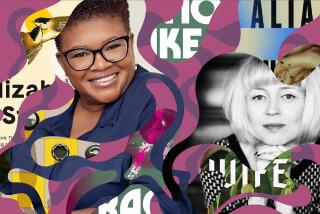COLUMN ONE : Anthology Rattles Tradition : New Heath collection broadens the scope of American literature with works by women and minorities. Opponents call it an affirmative-action approach.
- Share via
When UCLA English Prof. William D. Schaefer first saw some of the authors included in the new “Heath Anthology of American Literature,” he thought: “Who the hell are they?”
If Schaefer, former executive director of the national literary organization known as Modern Language Assn., had that reaction, most other scholars and students surely did too.
That’s just fine with the editors of the mammoth and controversial anthology. Their goal was to rattle traditions and to show that there are more master writers in American literature than, as several professors jokingly put it, “15 dead white men and Emily Dickinson.” As a result, the anthology has heated up a long-simmering debate central to the teaching profession: What should students read?
From the book’s start, with ancient Native American creation myths, to its finish 5,550 pages later with modern Chicano poets, the two-volume Heath work seeks to dramatically broaden the so-called canon with an unprecedented amount of writings by women and minorities. It claims to do so without kicking out many classics, but it still offends traditionalists who allege that the project takes an affirmative-action approach to literature.
“On one extreme is a very conservative group saying we have a canon of great literature that shouldn’t be altered,” said an official at the New York-based Assn. of Departments of English, who requested anonymity. “On the other side are people who say the canon has to be updated constantly as part of the ongoing expansion of knowledge. And the sides are doing battle.”
By their very aim to contain the best and most important writings, anthologies confer enormous authority and prestige on authors. For a poem or story to be included in a popular anthology for the first time means moving from the margin to the mainstream. Inclusion tells readers, in effect: This is a classic.
What’s more, such survey books usually are used in required college freshman and sophomore courses. Some of those students will never take an English course again and others will start lifelong enthusiasms based on something in an anthology. That’s why professors and critics argue so much about what should be in the books.
“We are trying to shed some light on the question of what’s first rate,” said Paul Smith, general acquisitions editor for D.C. Heath & Co., based in Lexington, Mass. “We are including writers who were not anthologized before, who may have been excluded in the past because of reasons of gender, race, class and politics, not necessarily quality.”
Such concerns are part of the wider debate at many American universities and colleges on how curriculum should reflect the multiethnic nature of their student bodies and the world beyond the campus. Two years ago, Stanford University expanded its required freshman humanities course to include non-Western material, despite strong criticism from then Education Secretary William J. Bennett and other conservatives that the change would erode values of Western civilization.
While most anthologies begin with Pilgrim writings, the Heath starts with nearly 200 pages of works by Native Americans, Spanish explorers and French settlers before getting to John Smith and William Bradford. Slave spirituals, the corridos folk ballads of Mexican-Americans and early feminist manifestoes are presented alongside selections from the Federalist Papers, Henry David Thoreau’s essays and short stories by Stephen Crane. Nathaniel Hawthorne and Walt Whitman are among the 275 authors represented, but so are Mourning Dove, the first Native American woman novelist, and contemporary Puerto Rican poet Victor Hernandez Cruz.
Critics complain that there is not enough of masters such as Henry Wadsworth Longfellow, Henry James or F. Scott Fitzgerald, and that many selections seem to have been chosen for their political rather than literary merits.
Slowly but surely, such traditionalists are losing the national fight over literary canon, both sides agree. Among the half-dozen best-selling anthologies, the trend over the last decade has been to broaden the study of American literature, first by adding women and black authors and, more recently, Latinos and Asians.
The dominant anthology is published by W. W. Norton & Co. in New York. Its third edition came out last year with 23 new writers, mainly women and minorities. A total Norton canon includes works by 180 authors contained in two volumes of 5,350 pages. Among the Norton additions are the autobiography of Olaudah Equiano, an 18th-Century slave; parts of the American Indian classic “Black Elk Speaks,” and a short story by Bobbie Ann Mason, a contemporary Southern woman.
Still, most scholars and rival publishers say nothing as dramatically inclusive as the Heath anthology has appeared before.
“It is quite revolutionary in its breadth,” commented UCLA’s Schaefer, who praised the Heath volumes and conceded that he never heard of included authors such as Julia A. J. Foote, a 19th-Century evangelist, or Sonia Sanchez, a contemporary black Muslim poet. Schaefer said he accepts the judgment of editors that such writers “may well be deserving.”
Wendy Martin, chair of the English faculty at the Claremont Graduate School and a member of the 14-member Heath editorial board, said all her colleagues on the project originally had no idea who some of the chosen writers were outside the editors’ own expertise. “It doesn’t mean those writers are not good. It just means that they were sadly neglected,” she stressed.
It is too soon to tell how the Heath anthology will do, although its editors are encouraged, reporting that teachers at about 300 universities and colleges, including UC Irvine and Cal State Long Beach, ordered the text for this fall. (Its average retail price is $27 a volume.) Some people connected with the project worry that academia’s resistance to change may limit sales.
Proponents of the Stanford change and the Heath anthology stress that the multiethnic nature of American campuses, especially in California, require teaching students about more than ancient Athens, Elizabethan London and 19th-Century Boston. Besides, they say, arguments over what is a masterpiece have been going on for generations; Herman Melville, author of “Moby Dick,” died in obscurity in 1891, and his works were not rediscovered until the mid-1920s.
Peter Shaw, vice president of the National Assn. of Scholars, a Princeton-based group of conservative academics, said his group opposes what he called “the affirmative action link” of the Heath work. Additions of what he considers minor writers because they represent women or ethnic groups “are not judgments of literature on merit, but for political reasons and are part of a larger politicization of both curricula and college teaching that we were formed to oppose,” said Shaw, who teaches humanities at St. Peter’s College in Jersey City, N.J.
Even if most traditional masters are included, teachers are tempted to scatter their energies on some undeserving authors during all too brief semesters, said James Tuttleton, a New York University English professor.
“These massive anthologies make it possible for anyone with any kind of ideological ax to grind to seriously shortchange students who, in my view, should be asked to read only the greatest and the best in the very short time they are in the classroom,” Tuttleton said. Publishers, he contended, fulfill demands of radical teachers as a way to boost sales.
The Heath project did grow out of a group of politically radical teachers dissatisfied with existing anthologies and tired of having to photocopy poems and short stories that they admired from out-of-print books, according to general editor Paul Lauter, a literature professor at Trinity College in Hartford, Conn. His early teaching experience with minority students in New York made him aware of how few canonized writers were relevant to his pupils, he said.
With grants from a federal agency and private foundations, Lauter and his colleagues surveyed professors around the nation about their ideas for a new basic text. The response was to shake things up. Readings, conferences and editing took about 10 years, with about 200 professors around the nation involved. Such a democratic process, cynics say, created a built-in market for the book.
“The goal was to represent the range of the cultures of America, cultures in the plural,” said Lauter. That was achieved by planning a very large anthology and by cutting less important works by famous authors, not by eliminating any major writer, he said.
For example, Hawthorne is represented by the novel “The Scarlet Letter” and several short stories, but only six personal letters, while more traditional texts include more letters. Melville’s novels “Billy Budd,” and “Benito Cereno” are included, along with several poems and stories, but his letters are not. The most famous essays of Ralph Waldo Emerson are there, but not his journals. Completely dropped for space reasons were Revolutionary War era satirist Henry Hugh Brackenridge and 19th-Century poets James Russell Lowell and Oliver Wendell Holmes, who appear in other anthologies.
Heath acquisitions editor Smith conceded that selections of some contemporary writers were influenced by the authors’ ethnicity and how their writings reflected that. For example, there was room for only one representative of modern WASP culture in the East, Smith said, and John Updike, not John Cheever, was selected, while Saul Bellow, not Bernard Malamud, was included to symbolize modern, urban Jewish writing.
Barry Wade, a Norton vice president and editor, described the changes in his anthology as evolutionary compared to the more radical approach at Heath. “From our point of view, they’ve done it at the expense of literature people want there or at the expense of complete works,” he said of his new rivals. The Norton anthology has, for example, about twice the Henry James material than in the Heath.
An otherwise highly favorable review of the Heath work in The Nation magazine last month questioned the small sections for Fitzgerald (one short story), Ernest Hemingway (one story), and William Faulkner (two stories). Heath editors say that was because those authors’ estates refused to allow more.
Heath’s selectiveness created room for writers such as Mary Boykin Chestnut, the Southern diarist of the Civil War; Charlotte Perkins Gilman, a feminist who died in 1935 and was rediscovered in the ‘70s; Amiri Baraka, the African-American playwright and poet formerly known as Leroi Jones; Sui Sin Far, the Chinese-American woman who fought discrimination in the 1890s, and Anzia Yezierska, a spokeswoman for the Russian-Jewish immigrant experience.
College freshmen often express surprise that so many women and minority writers existed, professors say, mainly because high school readings are so traditional.
Harper Lee (“To Kill a Mockingbird”) was the only woman among the top 10 most-assigned authors in public high schools, according to a national survey last year by the Center for the Learning and Teaching of Literature at the State University of New York at Albany. The other top nine were William Shakespeare, John Steinbeck, Charles Dickens, Mark Twain, Arthur Miller, George Orwell, Hawthorne, Hemingway, Fitzgerald and William Golding (“Lord of the Flies”). The most frequently assigned minority authors were Lorraine Hansberry (“A Raisin in the Sun”), ranked 42, and Richard Wright (“Native Son”), ranked 53.
Lauter said that if conservative critics would “get away from their ideological preconceptions and just read the texts,” they would be persuaded that the Heath selections are worthy.
He predicted that any efforts to halt expansion of what most people think of as American literature would meet the same fate as racial segregation in Southern schools. “The schools in Alabama were integrated,” Lauter said, “just as the curriculum will change too.”
More to Read
Sign up for our Book Club newsletter
Get the latest news, events and more from the Los Angeles Times Book Club, and help us get L.A. reading and talking.
You may occasionally receive promotional content from the Los Angeles Times.







